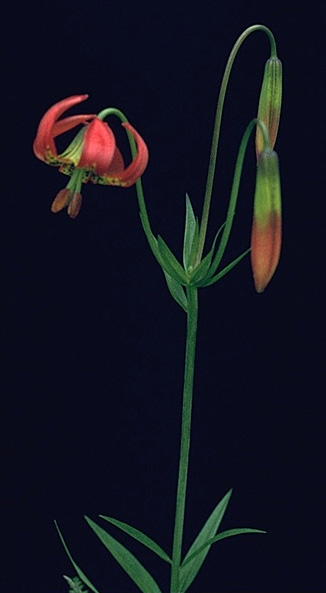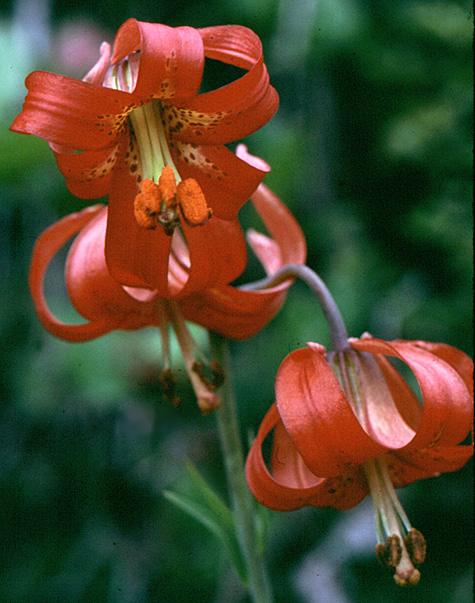Western Lily
Lilium occidentale (Western lily)
by Les Gottlieb
Eight species of lily grow naturally in Oregon, nearly all west of the Cascade crest. The rarest is the showy Lilium occidentale Purdy, commonly known as Western lily. The species is found in a narrow band along the Pacific coast, only a few miles wide, from near Coos Bay, Oregon to near Eureka, California. It grows along the edges of early successional sphagnum bogs, ponds and small channels, and on coastal prairie and scrub where soil is poorly drained and fog is frequent. Western lily is listed as endangered by the Federal government as well as by Oregon and California because numerous populations have been extirpated; fewer than 20 populations and about 3000 plants in flower in any one year remain today.

During the early and middle 20th century, thousands of plants were lost because breeders and plant enthusiasts overcollected this beautiful, easily recognized species. Many localities were destroyed because they were converted to agriculture (commercial cranberry bogs, clearing and drainage for livestock grazing) and other uses. Conservation of the species is complex because its habitat, an early stage in natural ecological succession, is unsuitable for long term persistence since it becomes shaded following invasion by pioneer trees and shrubs. Also, human activities have interrupted or reduced the natural formation of suitable bogs.
Western lily was first recognized as distinct by Carl Purdy (1861-1945), an active nurseryman and botanist and considered the leading Californian bulb authority during his lifetime (L. H. Irvine, 1905, History of the New California: its Resources and People). He built a successful trade in northern California specializing in the culture and botany of Pacific Coast bulbs. For a period, he worked with Luther Burbank hybridizing lilies and other monocots in an effort to select hardy and drought-resistant stock. Purdy was the author of 24 species, mostly in Liliaceae. Alice Eastwood (1859-1953), the prominent northern Californian botanist and horticulturist, named Brodiaea purdyi, Fritillaria purdyi and Iris purdyi for him.
Western lily was brought to Purdy’s attention by Native Americans whom he had hired to collect bulbs and other interesting plants in the area around Eureka, California, and he described it formally in 1897. The first collection in Oregon was made by M. E. Peck in 1913 near Brookings. Soon there was significant demand to collect and grow the species and within a few decades, Purdy lamented that very few plants could still be found in nature. This was the case until around 1990 when some large populations were discovered near Crescent City, California. Overall, nearly 2/3s of the 55 sites documented by specimen collections have been extirpated; of the remaining sites only two, at Crescent City marsh and Eureka, have more than a 1000 plants and several have fewer than 100 individuals. The species was listed as endangered by the Federal Government in 1994, and the Federal Recovery plan was published in 1998, hopefully, assuring a future for the plant. Critical habitat has not yet been designated.

Western lily grows to six feet or taller usually from a single stem that emerges from an asymmetrical, scaly rhizome (casually referred to as a bulb) that remains unbranched. The leaves are sometimes scattered but more typically are in 1–9 whorls, with three to many per whorl. The flowers are pendent. Typically, a plant displays 1–3 flowers but there may be as many as 25. A short distance above the conspicuously green, pendent floral base, the tepals (sepals and petals) recurve strongly upwards. The upper portion of the tepals is crimson to deep maroon, whereas the basal portion is yellow to green. Often there is an orange or yellow intervening band decorated with dark maroon or purple spots. The base of recently opened flowers has the appearance of a “green star;” older flowers show a yellow or yellow-orange star. The anthers are dull red or magenta and the pollen orange-brown to red-brown. The filaments of the stamens are straight and more or less parallel to the style and do not spread out from it. A complete description of the morphology of the plant and a key to distinguish the species of lilies is available at the Flora North America website (see below).
The position of the stamens and the presence of the green star readily distiuguish Western lily from the similar L. pardalinum pardalinum which has spreading stamens, larger red flowers and lacks the star. The similar L. maritimum, known from Mendocino and Sonoma Counties in California, is distinguished from Western lily by the more horizontal presentation of its flowers and by their bell-shape.
Flowering occurs from June to August. The species is the only North American pendant-flowered lily that is pollinated by hummingbirds, presumably attracted by flower color and a large production of nectar, measured as more than two times that of other lilies. Bees and other insects may occasionally transfer pollen. Reproduction is by seed, and the species does not form large colonies as many other lilies do because its rhizomatous bulb does not branch. Asexual reproduction may be possible from detached bud scales growing into new plants.
The species has definite requirements for a goodly level of direct sunlight and particular soils. Experiments have shown that it is shaded out when canopy cover exceeds 50%, often the case when nearby vegetation is dense or taller than 6.5 feet. This was demonstrated by removing spruce plants at one of its sites for a period of six years. Within two years, the number of lily plants increased a remarkable 20-fold. The species grows in soil that is poorly drained, slightly acidic and highly organic. It is also found in mineral-based soils derived from Cenozoic or older parent materials that are acidic and have a hard pan or shallow cemented iron pan within two feet of the surface. Invading trees and shrubs change its habitat because they produce shade and often lead to changes in hydrology detrimental to the lily (see the Center for Plant Conservation website below).
Acknowledgments:
I thank Charlene Simpson for helpful comments on the ms. and for permitting use of her gorgeous photo of L. occidentale. I thank Veva Stansell for reviewing the ms and sending it to David Imper who contributed very useful information about the current status of the lily.
Bibliography:
- U.S. Fish & Wildlife Service. 1994. Determination of endangered status for Lilium occidentale (Western Lily). Federal Register 59, 158:42171-42176**. (pdf, 2.1 MB)
- U.S. Fish & Wildlife Service. 1998. Recovery plan for the endangered Western lily (Lilium occidentale). Portland, Oregon. (pdf, 7.1 MB)
- U. S. Fish & Wildlife Service, Oregon Office. Description of Western Lily.
- Center for Plant Conservation profile of Lilium occidentale.
- Skinner, M.W. 2002. Lilium occidentale. In:Flora North America Editorial Committee, eds. 1993+. Flora of North America north of Mexico. 12+ vols. New York and Oxford. Vol. 26, p.186
- Rittenhouse, Bruce. 1996. Botanizing the southern Oregon coast (Coos Bay to Port Orford). Kalmiopsis 6:1-8.
- Guerrant, Jr., Edward O. 1996. Western Lily, Lilium occidentale (Liliaceae). Kalmiopsis 6:16-18.
- Imper, David K. 1997. Ecology and management of the endangered Western Lily (Lilium occidentale). In: Kaye, T.N., A. Liston, R.M. Love, D.L. Luoma, R.J. Meinke, and M.V. Wilson, eds. Conservation and management of native plants and fungi. Native Plant Society of Oregon. Corvallis.
